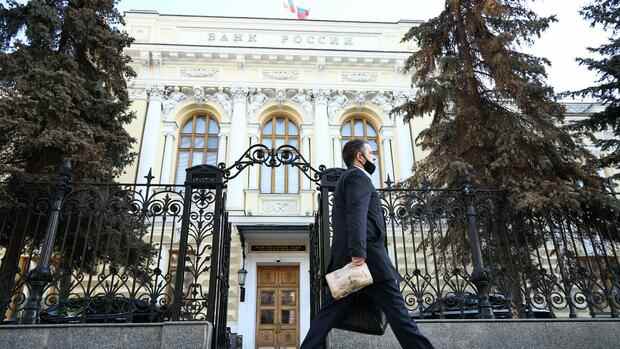Moscow The Russian central bank has eased its monetary policy again despite the ongoing sanctions against the country. The central bank announced on Friday in Moscow that the key interest rate would be reduced by 1.5 percentage points to 9.5 percent. On average, economists had expected a somewhat less significant interest rate cut to 10.0 percent.
It is the fourth rate cut in a row. This brings the main rate for supplying money to commercial banks back to the level it was before Russia invaded Ukraine on February 24th. The central bank also announced further cuts this year. The next meeting to review interest rates is scheduled for July 22nd.
In justifying the step, the central bank states that the “external environment for the Russian economy remains challenging and is significantly restricting economic activities”. At the same time, inflation is falling faster than expected in April, while the decline in economic activity is less than expected.
According to the central bank’s forecast, annual inflation will be between 14 and 17 percent in 2022 “given the current monetary policy stance”. So far, the forecast has been 18 to 23 percent inflation. For 2023, the central bank is forecasting a decline to five to seven percent and 4 percent in 2024 – the inflation target of the Russian central bank. However, despite a decline, the annual inflation rate was still 17.1 percent in May.
Top jobs of the day
Find the best jobs now and
be notified by email.
In addition, the head of the central bank, Elwira Nabiullina, was optimistic about consumer behavior in the country. It is true that many households stocked up a few months ago and therefore consumed less for a while. From their point of view, however, this will change again. “Consumption will start to return to its usual level,” said Nabiullina.
>> Read here: Central Bank Governor Nabiullina – The woman who saved Russia from collapse
The situation for companies affected by Western sanctions is not likely to normalize anytime soon. This affects above all the north-east of Russia. “Those regions that mainly ship their goods to Asia adapt more quickly to the new environment,” says Nabiullina.
The key interest rate has meanwhile been raised to 20 percent
In response to the sanctions imposed by western countries in response to Russia’s war of aggression against Ukraine, the central bank drastically raised the key interest rate by 10.5 points to 20 percent at the end of February. The central bank wanted to counteract the devaluation of the ruble and the risk of inflation.
The bank later lowered the key interest rate to 17 percent, and in April Nabiullina signaled its willingness to make further redemptions. This made credit cheaper again for companies and consumers. At the time, Nabiullina declared that one had to “create conditions to increase the availability of credit for the economy.”
At the end of May, the third rate cut to date followed, with the base rate being reduced by 3.0 percentage points to 11.0. Before the emergency increase to 20 percent on February 28, it was 9.5 percent, as it is now.
However, with the latest interest rate cut, the rate is well below the country’s inflation rate, which was 17 percent at the beginning of June. The central bank also announced that the decline in economic activity in the second quarter was less pronounced than expected. The decline for the year as a whole could also be lower than the April forecast. Russia’s economy grew by 4.7 percent in 2021.
Experts doubt that the ruble will remain strong in the long term
Recently, the ruble had recovered significantly. It is now even above the pre-war level. On Thursday, Russian President Vladimir Putin then exempted exporters from the obligation to exchange foreign exchange earnings. Until then, exporters generally had to convert 50 percent of their foreign exchange earnings into the local currency. In the future, instead, a government commission will determine how much of the income they have to pay for exchange, according to the presidential decree.
After the western sanctions following the Russian war of aggression against Ukraine initially led to a sharp devaluation of the ruble, the Kremlin, the government and the central bank reacted with sharp countermeasures in order to stabilize their own currency.
Among other things, Russians were temporarily no longer allowed to transfer money abroad and banks were no longer allowed to pay out foreign currency to citizens. Companies that received foreign exchange earnings from exports had to exchange them. Since imports – and thus demand for dollars and euros – collapsed as a result of the sanctions, the ruble rose significantly as a result.
According to currency analyst Tatha Ghose from Commerzbank, that could change again in the medium to long term. At Commerzbank, the forecast for the ruble exchange rate was therefore revised downwards – “after it became clear that the exchange rate no longer has a forward-looking component because sanctions and capital controls prevent a meaningful flow of capital”.
For this reason, the exchange rate is based on the daily demand and supply for the goods that can actually still be exported and imported, since Western sanctions have “immediately restricted imports of many categories”.
According to Ghose, however, the restrictions on oil and gas exports “will only come into play in the medium term”. In the meantime, Russia’s current account, i.e. the balance in trade in goods and services with foreign countries, “possibly shows an even larger surplus than before”.
As the embargoes on oil and self-sanctions on gas by Western countries come into effect in 2023, the surplus is “expected to decrease and the ruble to gradually weaken.”
More: Central Bank of Ukraine raises key interest rate to 25 percent

